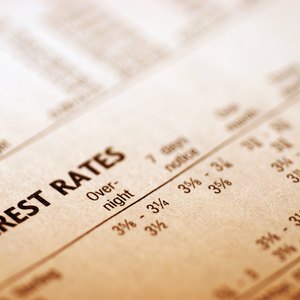
The lease on a long-term asset is considered a capital lease or operational lease for accounting purposes. With a capital lease, payments are considered both a liability and an asset on the firm's balance sheet because the business assumes some of the risk of ownership. The firm can deduct capital lease interest expenses on each year's tax return. To calculate the interest rate on a capital lease, the firm must know several elements, including the total amount financed, the monthly lease payment amount and the term of the lease.
Tips
In order to calculate capital lease interest rates, you must first determine whether or not your lease is capital or operational. Once this information is available, you can begin to discover the best method for calculating interest rates.
Capital versus Operating Lease
A lease must meet one of four criteria to determine if it is a capital or operating lease. According to rules set by the Financial Accounting Standards Board, a lease is considered capital if ownership will be transferred at the end of the lease, if there is an option to purchase the asset at a bargain price at the end of the lease, if the lease term exceeds 75 percent of the economic life of the asset or if the lease payments are more than 90 percent of the asset’s market value. If none of the conditions are met, the firm has an operating lease and must treat expenses related to the lease as an operating expense on the income statement.
Read More: How to Calculate Capital Lease Payments
Determine Total Amount Paid
Multiply the amount of the lease payment by the number of months in the lease term. This will provide the total amount paid out of pocket over the length of the lease. For example, if the monthly lease payment is $100 and the lease term is 24 months, the total amount paid out of pocket over the length of the lease is $2,400.
Subtract the amount financed from the total amount paid out of pocket, which will provide the total finance charge. Assuming the firm finances a total of $2,000, the total finance charge would be $400.
Determine Interest Paid
Divide the length of the term in years by the total finance charge to determine the total dollar amount paid in interest per year (finance charge per year). In the aforementioned example, it would be $400 divided by 2, or $200 paid in interest per year.
Divide the amount financed by the finance charge per year to receive the interest rate percentage of the capital lease. In the example, $2,000 divided by 200 gives you an interest rate of 10 percent.
About Debt Amortization
A firm must amortize the cost of a capital leased asset over the course of its usable life. To amortize a leased item, the firm must enter the monthly lease payment and the fair market value of the asset into an amortization table. This table is similar to a depreciation table used for assets that are purchased outright, such as real estate. The amortization table will enable the firm to determine the portion of the lease payment that is principal and the portion that is interest.
References
Tips
- A firm must amortize the cost of a capital leased asset over the course of its usable life. To amortize a leased item, the firm must enter the monthly lease payment and the fair market value of the asset into an amortization table. This table is similar to a depreciation table used for assets that are purchased outright, such as real estate. The amortization table will enable the firm to determine the portion of the lease payment that is principal and the portion that is interest.
Warnings
- A lease must meet one of four criteria to determine if it is a capital or operating lease. According to rules set by the Financial Accounting Standards Board, a lease is considered capital if ownership will be transferred at the end of the lease, if there is an option to purchase the asset at a bargain price at the end of the lease, if the lease term exceeds 75 percent of the economic life of the asset or if the lease payments are more than 90 percent of the asset’s market value. If none of the conditions are met, the firm has an operating lease and must treat expenses related to the lease as an operating expense on the income statement.
Writer Bio
Sherrie Scott is a freelance writer in Las Vegas with articles appearing on various websites. She studied political science at Arizona State University and her education has inspired her to write with integrity and seek precision in all that she does.

